Sociology Essay: Integration of Skilled Migrants in Australia
VerifiedAdded on 2023/04/25
|5
|1090
|301
Essay
AI Summary
This essay examines the social and cultural integration of skilled migrants into Australian society. It highlights the significant contributions of migrants, who represent diverse languages and nationalities, to the multicultural fabric of the nation. The essay discusses the role of organizations like the Council for Multicultural Australia (CMA) in supporting migrants and promoting cultural diversity. It analyzes the positive impacts on language skills, innovation, and educational enrichment, while also acknowledging potential challenges related to cultural clashes and language barriers. The essay further explores how migrants contribute to social cohesion, fill skill shortages, and enrich the workforce, ultimately fostering a more dynamic and productive society. The references include various research papers and studies that support the arguments made in the essay, providing a comprehensive overview of the topic.
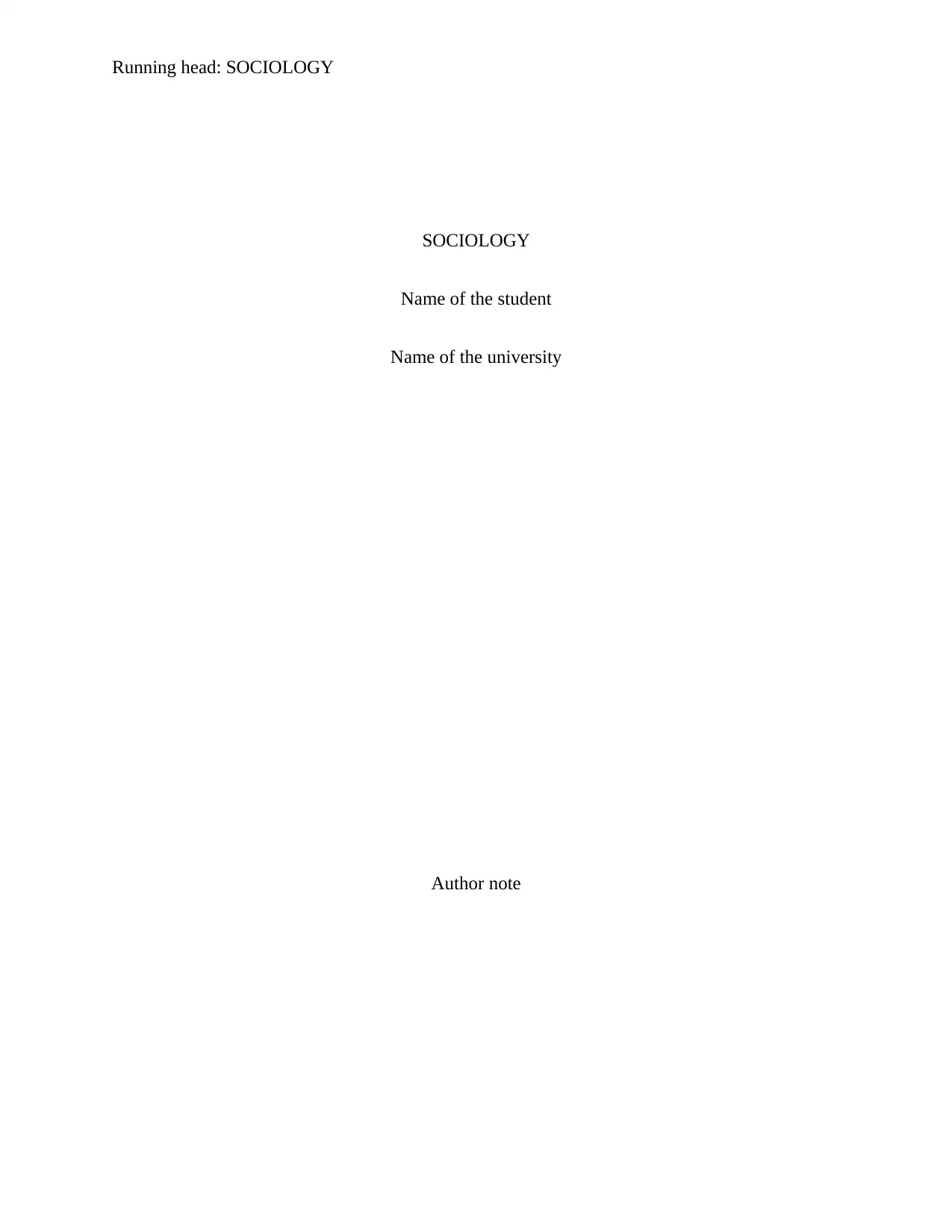
Running head: SOCIOLOGY
SOCIOLOGY
Name of the student
Name of the university
Author note
SOCIOLOGY
Name of the student
Name of the university
Author note
Paraphrase This Document
Need a fresh take? Get an instant paraphrase of this document with our AI Paraphraser
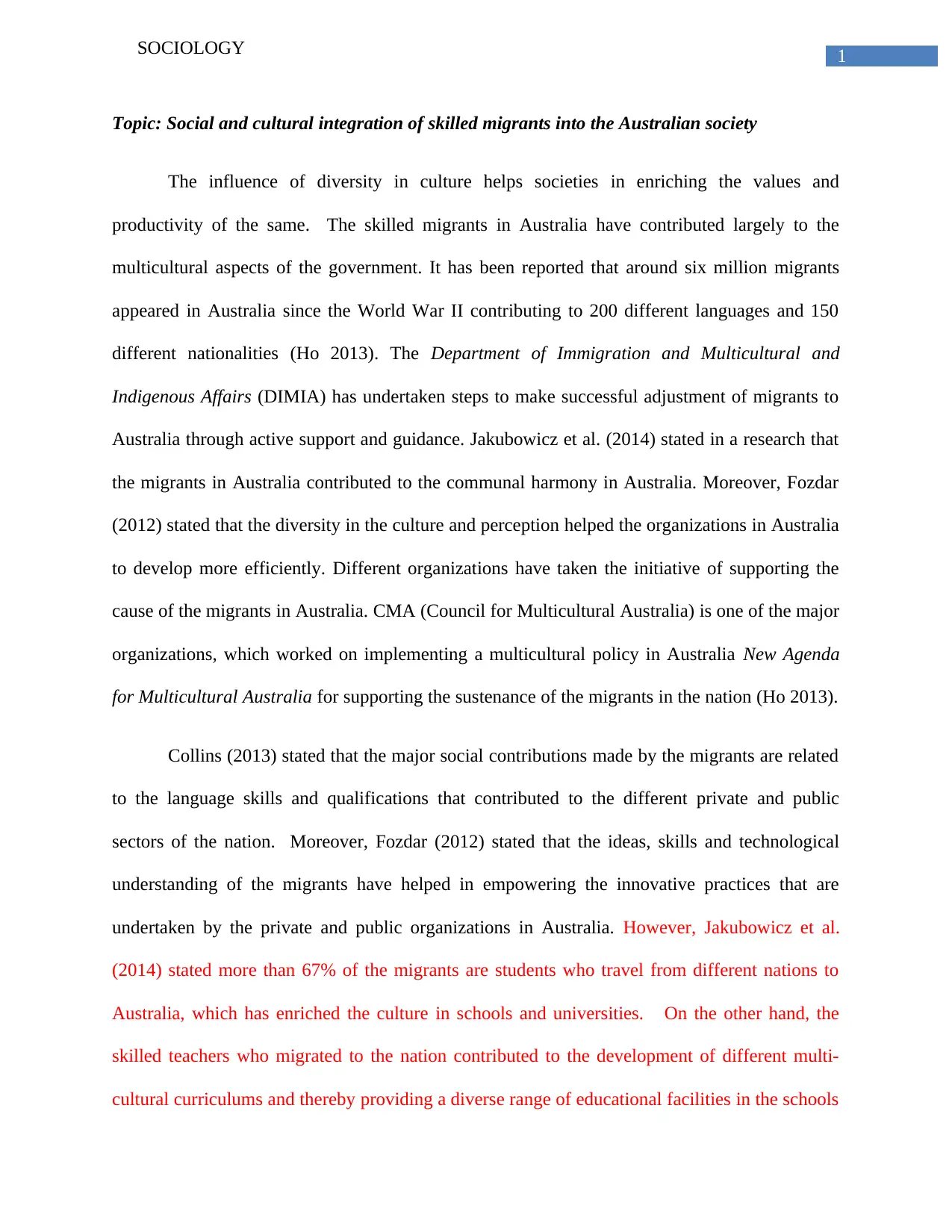
1SOCIOLOGY
Topic: Social and cultural integration of skilled migrants into the Australian society
The influence of diversity in culture helps societies in enriching the values and
productivity of the same. The skilled migrants in Australia have contributed largely to the
multicultural aspects of the government. It has been reported that around six million migrants
appeared in Australia since the World War II contributing to 200 different languages and 150
different nationalities (Ho 2013). The Department of Immigration and Multicultural and
Indigenous Affairs (DIMIA) has undertaken steps to make successful adjustment of migrants to
Australia through active support and guidance. Jakubowicz et al. (2014) stated in a research that
the migrants in Australia contributed to the communal harmony in Australia. Moreover, Fozdar
(2012) stated that the diversity in the culture and perception helped the organizations in Australia
to develop more efficiently. Different organizations have taken the initiative of supporting the
cause of the migrants in Australia. CMA (Council for Multicultural Australia) is one of the major
organizations, which worked on implementing a multicultural policy in Australia New Agenda
for Multicultural Australia for supporting the sustenance of the migrants in the nation (Ho 2013).
Collins (2013) stated that the major social contributions made by the migrants are related
to the language skills and qualifications that contributed to the different private and public
sectors of the nation. Moreover, Fozdar (2012) stated that the ideas, skills and technological
understanding of the migrants have helped in empowering the innovative practices that are
undertaken by the private and public organizations in Australia. However, Jakubowicz et al.
(2014) stated more than 67% of the migrants are students who travel from different nations to
Australia, which has enriched the culture in schools and universities. On the other hand, the
skilled teachers who migrated to the nation contributed to the development of different multi-
cultural curriculums and thereby providing a diverse range of educational facilities in the schools
Topic: Social and cultural integration of skilled migrants into the Australian society
The influence of diversity in culture helps societies in enriching the values and
productivity of the same. The skilled migrants in Australia have contributed largely to the
multicultural aspects of the government. It has been reported that around six million migrants
appeared in Australia since the World War II contributing to 200 different languages and 150
different nationalities (Ho 2013). The Department of Immigration and Multicultural and
Indigenous Affairs (DIMIA) has undertaken steps to make successful adjustment of migrants to
Australia through active support and guidance. Jakubowicz et al. (2014) stated in a research that
the migrants in Australia contributed to the communal harmony in Australia. Moreover, Fozdar
(2012) stated that the diversity in the culture and perception helped the organizations in Australia
to develop more efficiently. Different organizations have taken the initiative of supporting the
cause of the migrants in Australia. CMA (Council for Multicultural Australia) is one of the major
organizations, which worked on implementing a multicultural policy in Australia New Agenda
for Multicultural Australia for supporting the sustenance of the migrants in the nation (Ho 2013).
Collins (2013) stated that the major social contributions made by the migrants are related
to the language skills and qualifications that contributed to the different private and public
sectors of the nation. Moreover, Fozdar (2012) stated that the ideas, skills and technological
understanding of the migrants have helped in empowering the innovative practices that are
undertaken by the private and public organizations in Australia. However, Jakubowicz et al.
(2014) stated more than 67% of the migrants are students who travel from different nations to
Australia, which has enriched the culture in schools and universities. On the other hand, the
skilled teachers who migrated to the nation contributed to the development of different multi-
cultural curriculums and thereby providing a diverse range of educational facilities in the schools
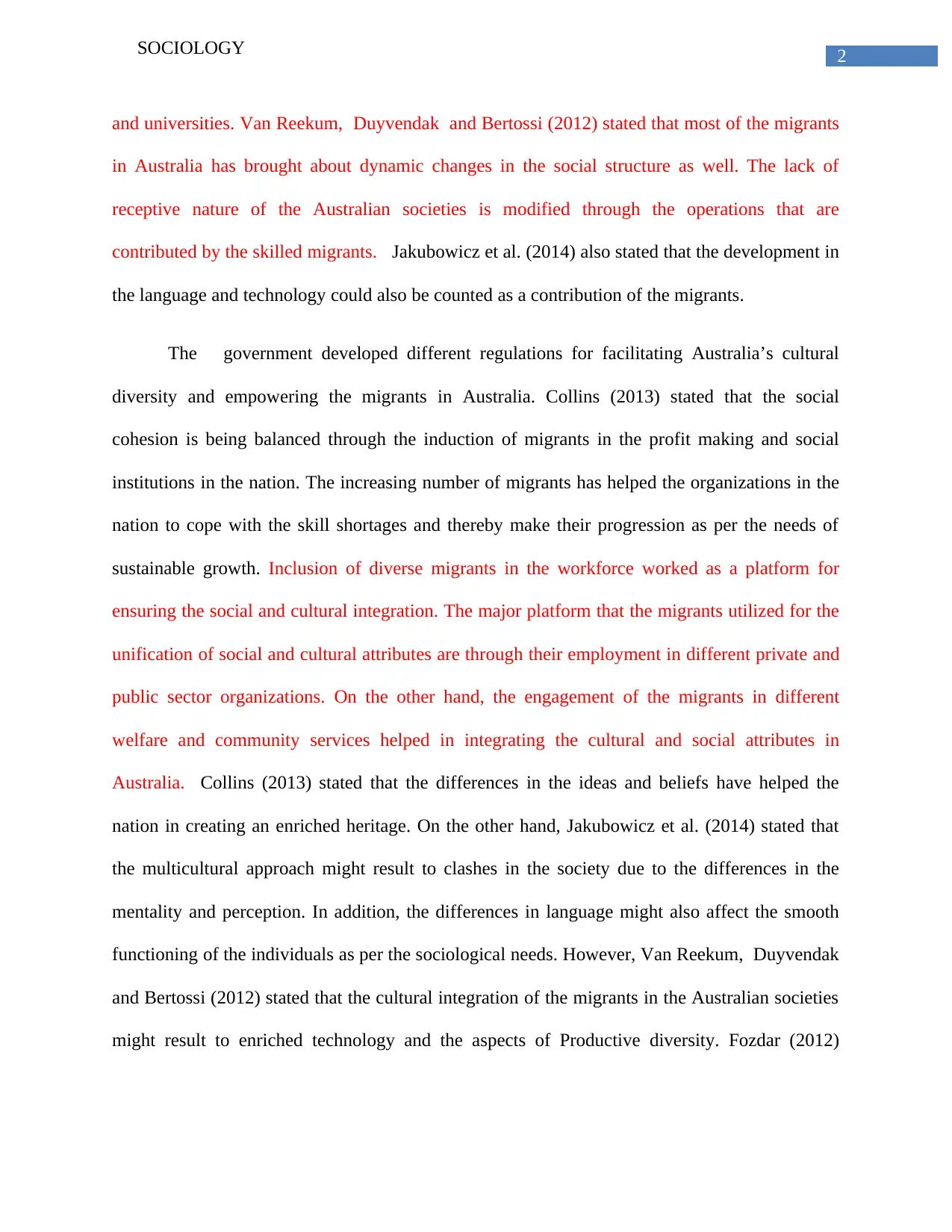
2SOCIOLOGY
and universities. Van Reekum, Duyvendak and Bertossi (2012) stated that most of the migrants
in Australia has brought about dynamic changes in the social structure as well. The lack of
receptive nature of the Australian societies is modified through the operations that are
contributed by the skilled migrants. Jakubowicz et al. (2014) also stated that the development in
the language and technology could also be counted as a contribution of the migrants.
The government developed different regulations for facilitating Australia’s cultural
diversity and empowering the migrants in Australia. Collins (2013) stated that the social
cohesion is being balanced through the induction of migrants in the profit making and social
institutions in the nation. The increasing number of migrants has helped the organizations in the
nation to cope with the skill shortages and thereby make their progression as per the needs of
sustainable growth. Inclusion of diverse migrants in the workforce worked as a platform for
ensuring the social and cultural integration. The major platform that the migrants utilized for the
unification of social and cultural attributes are through their employment in different private and
public sector organizations. On the other hand, the engagement of the migrants in different
welfare and community services helped in integrating the cultural and social attributes in
Australia. Collins (2013) stated that the differences in the ideas and beliefs have helped the
nation in creating an enriched heritage. On the other hand, Jakubowicz et al. (2014) stated that
the multicultural approach might result to clashes in the society due to the differences in the
mentality and perception. In addition, the differences in language might also affect the smooth
functioning of the individuals as per the sociological needs. However, Van Reekum, Duyvendak
and Bertossi (2012) stated that the cultural integration of the migrants in the Australian societies
might result to enriched technology and the aspects of Productive diversity. Fozdar (2012)
and universities. Van Reekum, Duyvendak and Bertossi (2012) stated that most of the migrants
in Australia has brought about dynamic changes in the social structure as well. The lack of
receptive nature of the Australian societies is modified through the operations that are
contributed by the skilled migrants. Jakubowicz et al. (2014) also stated that the development in
the language and technology could also be counted as a contribution of the migrants.
The government developed different regulations for facilitating Australia’s cultural
diversity and empowering the migrants in Australia. Collins (2013) stated that the social
cohesion is being balanced through the induction of migrants in the profit making and social
institutions in the nation. The increasing number of migrants has helped the organizations in the
nation to cope with the skill shortages and thereby make their progression as per the needs of
sustainable growth. Inclusion of diverse migrants in the workforce worked as a platform for
ensuring the social and cultural integration. The major platform that the migrants utilized for the
unification of social and cultural attributes are through their employment in different private and
public sector organizations. On the other hand, the engagement of the migrants in different
welfare and community services helped in integrating the cultural and social attributes in
Australia. Collins (2013) stated that the differences in the ideas and beliefs have helped the
nation in creating an enriched heritage. On the other hand, Jakubowicz et al. (2014) stated that
the multicultural approach might result to clashes in the society due to the differences in the
mentality and perception. In addition, the differences in language might also affect the smooth
functioning of the individuals as per the sociological needs. However, Van Reekum, Duyvendak
and Bertossi (2012) stated that the cultural integration of the migrants in the Australian societies
might result to enriched technology and the aspects of Productive diversity. Fozdar (2012)
⊘ This is a preview!⊘
Do you want full access?
Subscribe today to unlock all pages.

Trusted by 1+ million students worldwide
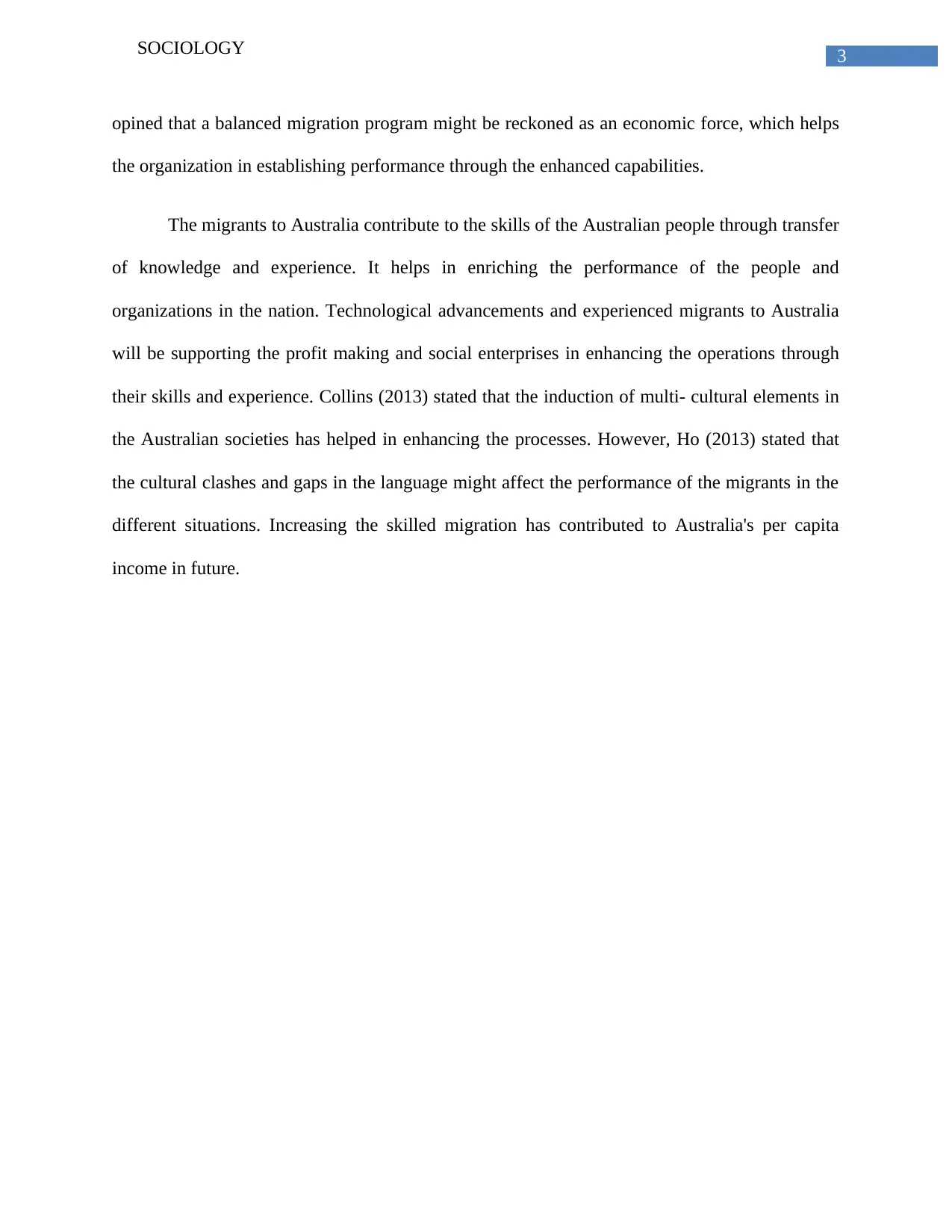
3SOCIOLOGY
opined that a balanced migration program might be reckoned as an economic force, which helps
the organization in establishing performance through the enhanced capabilities.
The migrants to Australia contribute to the skills of the Australian people through transfer
of knowledge and experience. It helps in enriching the performance of the people and
organizations in the nation. Technological advancements and experienced migrants to Australia
will be supporting the profit making and social enterprises in enhancing the operations through
their skills and experience. Collins (2013) stated that the induction of multi- cultural elements in
the Australian societies has helped in enhancing the processes. However, Ho (2013) stated that
the cultural clashes and gaps in the language might affect the performance of the migrants in the
different situations. Increasing the skilled migration has contributed to Australia's per capita
income in future.
opined that a balanced migration program might be reckoned as an economic force, which helps
the organization in establishing performance through the enhanced capabilities.
The migrants to Australia contribute to the skills of the Australian people through transfer
of knowledge and experience. It helps in enriching the performance of the people and
organizations in the nation. Technological advancements and experienced migrants to Australia
will be supporting the profit making and social enterprises in enhancing the operations through
their skills and experience. Collins (2013) stated that the induction of multi- cultural elements in
the Australian societies has helped in enhancing the processes. However, Ho (2013) stated that
the cultural clashes and gaps in the language might affect the performance of the migrants in the
different situations. Increasing the skilled migration has contributed to Australia's per capita
income in future.
Paraphrase This Document
Need a fresh take? Get an instant paraphrase of this document with our AI Paraphraser
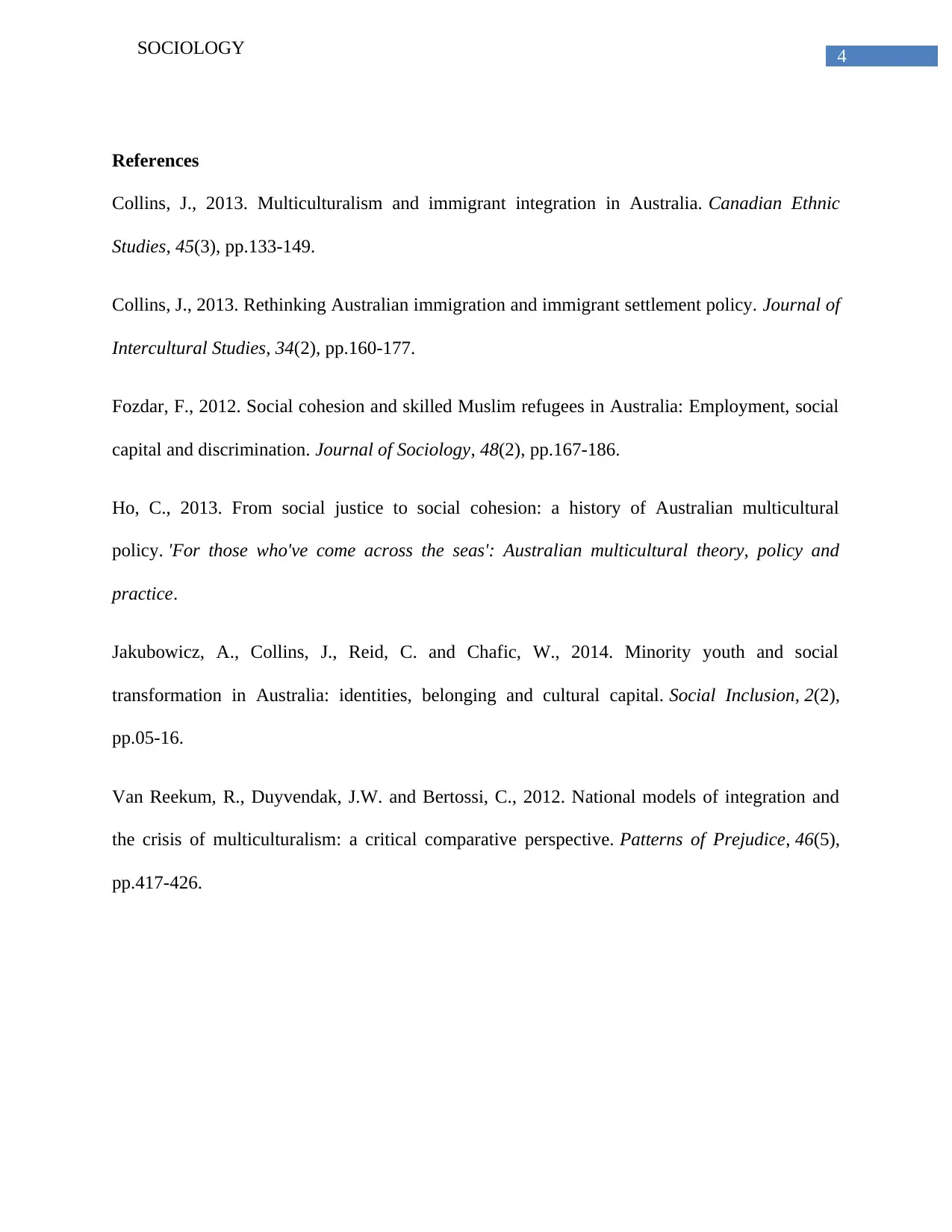
4SOCIOLOGY
References
Collins, J., 2013. Multiculturalism and immigrant integration in Australia. Canadian Ethnic
Studies, 45(3), pp.133-149.
Collins, J., 2013. Rethinking Australian immigration and immigrant settlement policy. Journal of
Intercultural Studies, 34(2), pp.160-177.
Fozdar, F., 2012. Social cohesion and skilled Muslim refugees in Australia: Employment, social
capital and discrimination. Journal of Sociology, 48(2), pp.167-186.
Ho, C., 2013. From social justice to social cohesion: a history of Australian multicultural
policy. 'For those who've come across the seas': Australian multicultural theory, policy and
practice.
Jakubowicz, A., Collins, J., Reid, C. and Chafic, W., 2014. Minority youth and social
transformation in Australia: identities, belonging and cultural capital. Social Inclusion, 2(2),
pp.05-16.
Van Reekum, R., Duyvendak, J.W. and Bertossi, C., 2012. National models of integration and
the crisis of multiculturalism: a critical comparative perspective. Patterns of Prejudice, 46(5),
pp.417-426.
References
Collins, J., 2013. Multiculturalism and immigrant integration in Australia. Canadian Ethnic
Studies, 45(3), pp.133-149.
Collins, J., 2013. Rethinking Australian immigration and immigrant settlement policy. Journal of
Intercultural Studies, 34(2), pp.160-177.
Fozdar, F., 2012. Social cohesion and skilled Muslim refugees in Australia: Employment, social
capital and discrimination. Journal of Sociology, 48(2), pp.167-186.
Ho, C., 2013. From social justice to social cohesion: a history of Australian multicultural
policy. 'For those who've come across the seas': Australian multicultural theory, policy and
practice.
Jakubowicz, A., Collins, J., Reid, C. and Chafic, W., 2014. Minority youth and social
transformation in Australia: identities, belonging and cultural capital. Social Inclusion, 2(2),
pp.05-16.
Van Reekum, R., Duyvendak, J.W. and Bertossi, C., 2012. National models of integration and
the crisis of multiculturalism: a critical comparative perspective. Patterns of Prejudice, 46(5),
pp.417-426.
1 out of 5
Related Documents
Your All-in-One AI-Powered Toolkit for Academic Success.
+13062052269
info@desklib.com
Available 24*7 on WhatsApp / Email
![[object Object]](/_next/static/media/star-bottom.7253800d.svg)
Unlock your academic potential
Copyright © 2020–2025 A2Z Services. All Rights Reserved. Developed and managed by ZUCOL.





